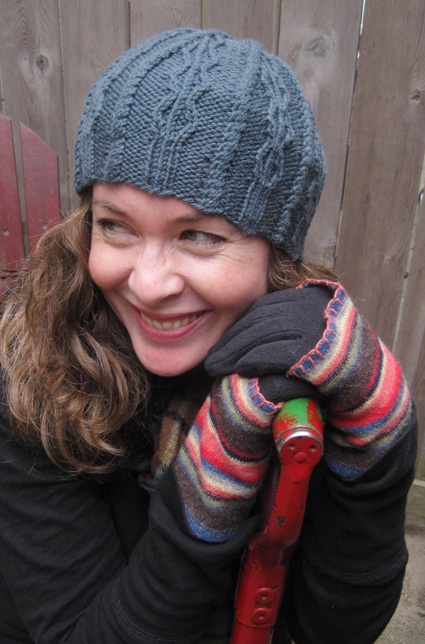

|
|
|

Recently I woke in the night to find one half of my mind fretting over things I couldn’t change, and the other designing a hat that incorporated all my tossing and turning and trailing after the worrying part of my brain – plus a tidy way to incorporate crown decreases into a cable. In the morning, I started knitting.
|
||
|
|

|
Tweet
|
|
SIZE |
|
|
FINISHED MEASUREMENTS |
|
MATERIALS Notions |
|
GAUGE |
21 sts/26 rounds = 4 inches
in stockinette stitch |
|
PATTERN NOTES |
|
Sleepless is succinct in length, both to keep it from being pushed out of place by a coat collar and to ensure it's a quick, giftable knit demanding just one 50g ball of yarn. If yardage is not a problem and you wish to make it longer, simply add repeats of Band rounds 1 and 2 (gaining approximately a quarter inch each time) and/or Body rounds 1 to 8 (gaining approximately an inch each time.) Because each size is designed with the same number of panels, the number of stitches and how they're handled within each panel are different. You can see how before you cast on - the light grey hat pictured here was knit in size M and the dark grey in L. The high ridges in this hat are produced by adapting the classic Twist stitch to take two sts over the top while holding just one in back. So as not to confuse it with the traditional one-plus-one Right Twist, it is called Double Right Twist, or DRT. In the crown, an extra st is cleverly added to the DRT, held in back with the single st and these two worked together for a decrease. This adjustment is called Double Right Twist Decrease, or DRT-dec. T1L: twist 1 left: slip next st to cable needle and hold in front of work, p1, then k1 from cable needle.T1R: twist 1 right: slip next st to cable needle and hold in back of work, k1, then p1 from cable needle. DRT: double right twist: slip next st to cable needle and hold in back of work, k2, then 1 from cable needle. DRT-dec: double right twist with decrease: slip next 2 sts to cable needle and hold in back of work, k2, then k2tog from cable needle. m1p: make one purlwise: Insert left needle, from front to back, under strand of yarn which runs between last stitch on left needle and first stitch on right needle; purl this stitch through back loop. |
|
|
DIRECTIONS Setup round: *P2[2, 3], k1, k1[2, 1] tbl, k1, p2[2,
3], k3; repeat from * to end of rnd. Body Work from written instructions or chart as you prefer. When hat gets too small to work comfortably on 16-inch circular, switch to DPNs, magic loop or 2 circulars as you prefer. Round 1: *P3[3, 4], T1R, k1[2, 1] tbl, T1L, P2[2, 3], DRT-dec;
repeat from * to end of rnd. 117[126, 135] sts Cut yarn, leaving an 8-inch tail. Thread yarn tail through rem sts and pull to secure. |
|
FINISHING |
| ABOUT THE DESIGNER |
|
Mary Keenan is a writer who spends a lot
more time knitting than is good for her
(depending on how you define ‘good’,
which depends on whether or not you’re getting the hat that’s
coming off the needles.) |
|
Pattern & images © 2011 Mary Keenan. Contact Mary |